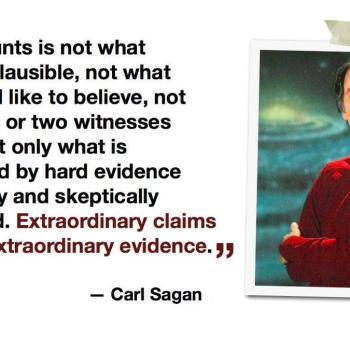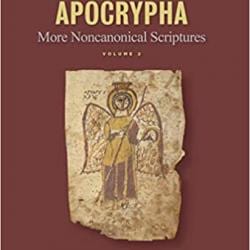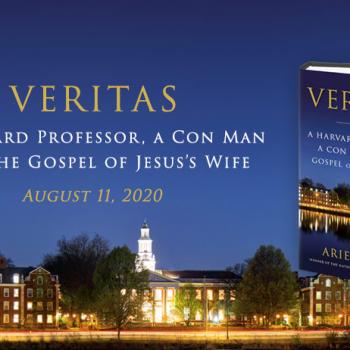I chaired this session, and so took the opportunity to take a photo of the audience (see below). The first presenter was Tony Burke, a key organizer of the event, but this was his first time presenting, apparently. His paper explored forgeries in centuries past, and how these things compare to genuine discoveries. Sometimes lack of detail was common in the time. As scholarship develops and gets more sophisticated, so too do forgers. He also notes the tendency of Classicists to focus on forgeries which undermined their own work, leaving others alone, and examples of the same individual exposing and creating forgeries. “The discovery of forgery is never neutral” (Paul Baines, House of Forgery). Burke discusses how Secret Mark looks in comparison with actual forgeries, noting that, if the perception of homosexuality had not offended scholars, certain accusations of forgery might never have occurred. If some have accused Smith of making the forgery to further his career, Stephen Carlson also got a career boost from his book making the accusation. Both forgery and accusation of forgery can be motivated in certain ways. Burke says he is probably preaching to the choir in saying that it is dubious to call modern apocrypha “forgeries” but not ancient ones. The creation of a married or a Buddhist Jesus is worthy of study in relation to the religious sensibilities and desired of people in specific times. Renaissance and modern scholars have sometimes done exactly what ancient theologians did, and regarded as forgery texts which they disliked. Do we have our own version of heresy hunters, telling us to steer clear of or avoid reading particular things? Stan Porter asked why one text becomes a focus of ongoing accusations of forgery but another not, something the fuller version of Burke's paper addresses in connection with the Gospel of Judas. Burke noted how arguments which were shown to be of dubious weight have continued to be repeated on the internet and elsewhere. Mark Goodacre raised a question of whether we are engaging in mindreading when we say people are motivated by dislike of a text. In response, Burke notes how Craig Evans, for instance, shows his concerns when he reads things into the text of the Secret Gospel of Mark, saying that someone is naked in the text when that isn't so. Goodacre said that the disposition may not be against Jesus being married or gay, but towards debunking and skepticism, leading to interesting discussion of that as an appropriate disposition for scholars. Bart Ehrman said that most in the audience when Karen King first presented the Gospel of Jesus' Wife were not convinced it was authentic. He also mentions that, while some (not all) Christians in antiquity were concerned about forgery for theological reasons, others simply wanted to know whether things were written by who they said they were. Janet Spittler suggested that Mark Goodacre was risking sounding like Richard Carrier, whose very long book engages in “skepticism” which claims we have to go back and start from square one. Carrier Schroeder noted that people do make jokes about Smith and homosexuality, and that Carlson's phrase “lifelong bachelor” is a code for that, and that so too gender issues and sexism were there from the beginning in discussions of the Gospel of Jesus' Wife. Burke mentioned my thought experiment on this blog about whether the same attitude and approach would have led us to deem the Gospel of Philip forgery, if it came to light in the same way as GJW. Another commenter pointed out that the “skeptical” approach is not as bias-free or without agenda as is often claimed.
Bradley Rice focused on the story of Jesus going to India known as the Life of St. Issa. This is an influential text in discussions of the so-called “lost years” of Jesus. He began by retelling the tale itself and Notovitch's story about how he discovered it. Rice is following Piovanelli in saying that Christian forgeries of the modern era deserve to be studied as remythologizations of the Christian tradition. There is a lot we know about Notovitch (although unfortunately mostly from Notovitch himself), which ought to be considered by interpreters of the text he created. In Notovitch's story, the Jews wash their hands and the blame for Jesus' death lies with Pilate, and this may be connected with the fact that Notovitch was born Jewish, and the critical situation of Jews in Russia. He calls Alexander III “the shadow of the Orthodox God.” Pilate is an angry character who sends out spies to report on Jesus – could this be referring to the Czar? These deserve to be compared with the opposite trajectory in ancient literature about Pilate. Rice talked about the current love of filling in gaps in the life of Jesus, and mentioned Anne Rice – who, he pointed put, is no relation to him. While hating the term “New Age,” that movement's embrace of Indian religion may account for the popularity of the Life of St. Issa and also the Aquarian Gospel. The nineteenth century saw the (re)discovery of Indian texts, the similarities of which to Jesus' teaching had been noted, and so many wondered whether there could be any genuine connection between the two. Rice suggests that Notovitch was trying to provide a universal religion that could embrace Eastern thought without (he apologizes for the pun) “sacrificing Jesus.” In the question time, Piovanelli pointed out that, while Notovitch was sent to Siberia when his forgery was discovered, the forgers of the Protocols of the Elders of Zion were not. Piovanelli also asked whether this text can be relevant to the quest of the historical Jesus, and also made a comparison between our discussion of texts here today, and the topic of the non-textual forgery, the Shroud of Turin. He also said that he has thought about creating a full version of Clement's letter to Theodore about Secret Mark in Ethiopic, to illustrate how easily forgeries can be created. If it had been appropriate, I would have suggested that someone really ought to do that, or something like it, to see whether it is in fact as “easily done” as Povanelli claimed. Brent Landau asked about the use of the name Issa. Tim Pettipiece mentioned the distinction between factuality and authenticity and our inability to convey such nuance in a tweet. Anne Moore appreciated the accentuation of how popular theosophy was in that era. Janet Spittler asked whether any of the ancient things associated with India are included in the text. Rice replied that the feel of it is largely Judeo-Christian and theosophic. Jesus does no miracles in the text, probably under the influence of the lives of Jesus of that time, and he gets into debates with the brahmins about the caste system.
Eric Vanden Eykel spoke about expanding the apocryphal corpus, and in introducing it I could not help remarking that we have been expanding the apocryphal corpus throughout the whole symposium. Vanden Eykel also said that his wife thought he should apologize for the pun on “novel” in his paper's title. His focus in the paper was on works of Christian fiction by living authors who are known. Can studying these contribute to our field? He has taught courses which involve reading novels about Jesus, and two reactions interest him. Some students say “I never knew that's what Jesus was like,” missing that these works are fiction. Others say that, even though they know the works are fiction, it will affect the way they view Jesus from then on. Among the books Vanden Eykel mentioned are Christopher Moore's Lamb: The Gospel according to Biff, which although comedic in intent has connections with ancient apocrypha like the Infancy Gospel of Thomas as well as the “Jesus in India” tradition; Bruce Longenecker's The Lost Letters of Pergamum, which sees Luke convert someone named Antipas to whom he sends a copy of the literary work he has been working on; and Colm Toibin's Testament of Mary, which depicts a cynical and suffering Mary. Then he discussed methodology. In this case we know a great deal more than we tend to about comparable ancient works: who wrote them, what sources they used, where they were sold, and in how many copies, and so on. These allow us to see how contemporary culture impinges on literary creations, as pertains to reception history. How are readers making sense of these texts? How do these works change the way readers read the sources the authors draw on? In the question time, Brandon Hawk asked about how the widespread appreciation of Toibin as an author relates to the reception of this particular novel. Vanden Eykel noted how the same readers tend not to like both Lamb and other novels by Moore. Brent Landau asked whether The Passion of the Christ is a better example of Christian apocrypha than Lamb, because the latter lacks a religious devotional intent. Vanden Eykel responded by noting that the passion account in Lamb is moving, as is the ending. Anne Moore notes that Toibin's book is a trauma victim's novel, and relates to the Catholic tradition of Mary mother of sorrows. Another person asked whether these have been responded to with negative attacks from defenders of orthodoxy, the way ancient apocrypha have been. Vanden Eykel replied by noting Amazon reviews written by the pious. Tony Burke asked whether any ancient apocrypha were intended as fiction just like these modern examples. Ancient novels are not that different from modern novels in certain respects.
The last paper in the session is a continuation of work Scott Brown did for the 2012 symposium (and published in the resulting conference volume), and he said that it might be his last one on Secret Mark, or better, the Mystic Gospel of Mark. Brown has been an important defender of the authenticity of the letter of Clement to Theodore, showing that it reflects Clement of Alexandria's viewpoint very well. What Clement says about the “great mysteries” in other works has elders instructing students in a way that fits Longer Mark. Longer Mark fits the practice of the Alexandrian church, and so Brown explored what Clement might have thought about the interpretation of other details in Longer Mark. Clement mentions seeking to preserve mysteries so that they will not be lost, but in an obscure way to keep them from the unworthy. If the Mystic Gospel is an authentic ancient work, then we should expect to see its interpretation scattered “like flowers in a meadow” throughout Clement's writings. Mentioning the work of Alain Le Boulluec, Brown says that there are elements of Clement's writings which seem best explicable in terms of Clement having been influenced by Longer Mark. Brown says that what he found far exceeded his expectations. In the question time, mention was made of the notes that Morton Smith made in the margins of his copy of Clement and other texts, including his own book, trying to make sense of Longer Mark. Smith wished he could have had a second edition in which he could have revised his interpretation. Stan Porter shared his experience of asking Morton Smith about the accusation of forgery, and Brown shared that notes about reviews are found in the front and back pages of Smith's copy of his book. A number of his books have annotations, and so we can see what was in his mind as he worked on his own books, as well as later. Smith was angry that Pascal had revised his book but did not say that the accusation of fraud was what was wrong with the first edition. Smith apparently said at one point that he wished he were so clever as to be able to forge a work like the Clement letter, so he might have appreciated Pantuck's argument. Mark Goodacre asked about the reference to “naked man with naked man,” which Clement denies is in the text of Longer Mark. Brown suggested that Clement accepted a Christianized version of the “ladder of love,” noting his connection of union with entry into the noetic world. Carpocrates may have included a version of that, where Clement's toned down version is “lover and beloved stand together at this point.” It may be that that was not something in any copy of the text, but an element of interpretation. Even so, that might not have involved homosexual intercourse. Goodacre asked why Clement would have thought that was blasphemous, and Brown said because it could be taken literally in an inappropriate manner. I asked Brown to mention some details he skipped from his paper: Clement focuses on the linen garment of the high priest in the Day of Atonement ritual, and focuses on the seven day ritual of purification from corpse impurity, things which make better sense if Clement was trying to make sense of Longer Mark. Longer Mark makes some elements of Clement's thought less strange. Brent Landau asked if there are other examples of very ancient Christian works being found only in a late copy like this. Piovanelli says yes, but not copied into the back of another book. I thought of Mandaean texts as examples. Tony Burke mentioned that he is pretty sure there are others. Brown asked whether the elements about this that are exceptional make it more suspect or less.
We had some time left for more discussion about any papers in the session at the end. Brent Landau mentioned that there is a long history of people objecting to Christian apocrypha, and that scholars in this field can have a knee jerk reaction when others, including fellow scholars, seem to be repeating the same kind of language. Tony Burke mentioned a session at SBL on the subject of writing about Christian apocrypha for general audiences. Bob Cargill had suggested that journalists should steer clear of pseudoscholars, and that seemed ironic in a session about Christian apocrypha, texts that people were warned to steer clear of in the past. Another question asked about intended audiences of the novels mentioned in Vanden Eykel's paper – which are trying to introduce people to Jesus, and which assume one already has a certain view of Jesus? He said that Lamb is full of references which one will not get without significant sophisticated knowledge of the Biblical text and ancient Judaism. They do not seem marketed at younger readers. Longenecker's seems aimed at an Evangelical kind of crowd. Moore has an afterword talking about his aims in writing Lamb. Moore has a resurrection, while Toibin has the disciples steal Jesus' body and bury it in the desert – so which is more reverent? Brent Landau asked whether the angel appearing ten years late reflects the discrepancy between Luke and Matthew.













